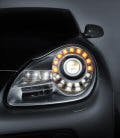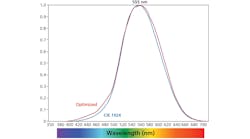Renault says that with their small size, powerful light emission, extreme reliability, low energy requirement, and long lifespan, LEDs are the technology of the future for automotive lighting.
With a light color close to that of daylight, the LED headlights increase visual comfort and road visibility.
In the directional lighting system, the electronic LED control unit adjusts the amount and direction of light according to the steering angle. On a winding road, the direction of the beam is electronically managed, while on the motorway, the LEDs are activated and controlled automatically to provide optimal range without dazzle at all times.
Adaptive front lighting
XLED combines LEDs with a xenon module, which provides low- and high-beam functions and a (mechanical) dynamic bending light.
The LEDs together with sensor and actuator technologies respond to different road and weather conditions and adapt the lighting patterns accordingly. A daytime running light, a progressive bending light (providing optimized illumination around curves and at intersections) and a motorway light (providing enhanced visibility on highways) are all enabled by the LED lights.
Valeo says that the adaptive front lighting system can be custom-designed for applications on a wide range of vehicles, and that regulatory approval is anticipated shortly for a lunch on 2007/2008 vehicle programs.
Microoptics technology for rear lighting
Meanwhile, the technology can be used to build center high-mounted stop lamps (CHMSLs) with 4 LEDs to illuminate the signal, rather than having 12-16 individually-visible LEDs.
The company is also promoting its proprietary Mono-LED technology which enables all rear signal functions by using one high-power LED per function.









